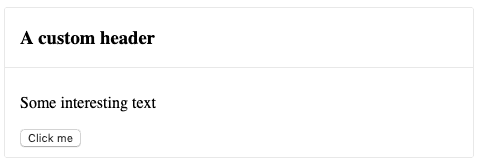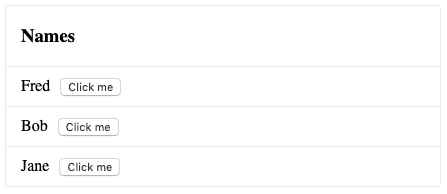Render props are still useful
The render props pattern has been a popular way to share logic between components. Since React 16.8 custom hooks are a more elegant way of sharing logic between components. So, no need for render props now then? No! Render props are still useful for building reusable components …
What is a render prop?
A render prop is a prop that is a function that renders something - i.e. a function that returns JSX:
interface Props {
...
renderItem?: (item: string) => JSX.Element;
renderHeader?: () => JSX.Element;
}They can be used to delegate the rendering of bits of a component to the consumer of the component. This can make a component very flexible and highly reusable.
Every component already has a render prop!
Every React component has a children prop:
export const Card: FC = ({ children }) => (
<div className="card">{children}</div>
);This is a render prop! In the above example the children prop allows the consumer of the component to render the content of the card.
<Card>
<p>Some interesting text</p>
<button>Click me</button>
</Card>Above is an example of consuming the Card component. The paragraph and button elements nested inside Card are picked up as the children prop and rendered inside the card div:
Creating a render prop
We can create our own render prop:
interface Props {
title?: string;
renderHeader?: () => JSX.Element;
}
export const Card: FC<Props> = ({ children, title, renderHeader }) => (
<div className="card">
<div className="card-header">
{renderHeader ? renderHeader() : title !== undefined ? title : null}
</div>
<div className="card-content">{children}</div>
</div>
);We have extended the Card component to have a header. The consumer can override default appearance using the renderHeader render prop:
<Card renderHeader={() => <h3>A custom header</h3>}>
<p>Some interesting text</p>
<button>Click me</button>
</Card>Above is an example of consuming the Card component supplying the header using the renderHeader prop. We simply assign the renderHeader prop to an inline arrow function that returns a h3 containing our title.
We are now starting to understand the power of render props and how it makes a component super flexible and reusable.
Reusable list
A common use case for render props are list components:
interface Props {
data: string[];
renderItem?: (item: string) => JSX.Element;
renderHeader?: () => JSX.Element;
}
export const List: FC<Props> = ({ data, renderItem, renderHeader }) => (
<div className="list">
<div className="list-header">{renderHeader && renderHeader()}</div>
<ul>
{data.map(item => (
<li key={item}>{renderItem ? renderItem(item) : item}</li>
))}
</ul>
</div>
);Above is a simple List component that has render props for the list header and list items. Notice that renderItem has a parameter for the data item to be used when rendering the item.
<List
data={["Fred", "Bob", "Jane"]}
renderHeader={() => <h3>Names</h3>}
renderItem={item => (
<div>
<span style={{ marginRight: "10px" }}>{item}</span>
<button>Click me</button>
</div>
)}
/>Above is an example of consuming the List component. We render the list header using a h3 using the renderHeader prop. We render each data item in a span with a “Click me” button alongside it using the renderItem prop. Below is the result:
Nice!
Wrap up
Render props are still really useful when we are creating highly reusable components that allow the consumer to render custom elements.
Every React component automatically has a children prop for allowing the consumer to render a single bit of the component.
We can create our own render props in a component where we want to allow the consumer to render different bits of a component.
Render props can take in parameters which is useful when the render prop is being used to render a collection of data items.
If you to learn more about using TypeScript with React, you may find my course useful:




